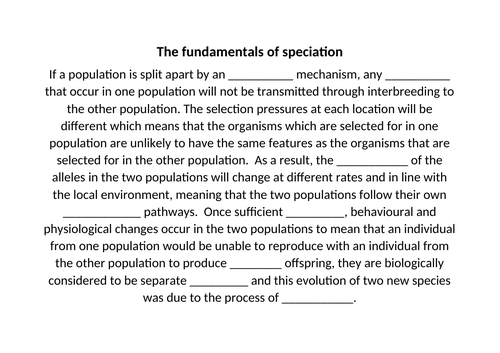



This fully-resourced lesson explores how reproductive isolation can potentially lead to the formation of a new species by speciation . The engaging PowerPoint and accompanying resources have been designed to cover point 5.19 of the Pearson Edexcel A-level Biology A (Salters Nuffield) specification which states that students should understand how isolation reduces gene flow between populations which can lead to allopatric or sympatric speciation.
The lesson begins by using the example of a hinny, which is the hybrid offspring of a horse and a donkey, to challenge students to recall the biological classification of a species. Moving forwards, students are introduced to the idea of speciation and the key components of this process, such as isolation and selection pressures, are covered and discussed in detail. Understanding and prior knowledge checks are included throughout the lesson to allow the students to not only assess their progress against the current topic but also to make links to earlier topics in the specification. Time is taken to look at the details of allopatric speciation and how the different mutations that arise in the isolated populations and genetic drift will lead to genetic changes. The example of allopatric speciation in wrasse fish because of the isthmus of Panama is used to allow the students to visualise this process. The final part of the lesson considers sympatric speciation and again a wide variety of tasks are used to enable a deep understanding to be developed.
Get this resource as part of a bundle and save up to 39%
A bundle is a package of resources grouped together to teach a particular topic, or a series of lessons, in one place.
Topic 4: Biodiversity and natural resources (Edexcel SNAB)
This lesson bundle contains 10 lesson PowerPoints and their accompanying resources which are filled with a wide variety of tasks to motivate and engage the students whilst covering the detailed content of topic 4 of the Pearson Edexcel A-level Biology A (Salters Nuffield) specification. Extensive planning has gone into each lesson to ensure that understanding is complete and that students are challenged to make links to previously covered topics. The tasks include exam-style questions, differentiated tasks, guided discussion points and quick quiz competitions and together these cover the following specification points in topic 4: * The meaning of the terms biodiversity and endemism * Measuring biodiversity within a habitat using species richness and within a species by calculating the heterozygosity index * Comparing biodiversity between habitats by calculating an index of diversity * The concept of niche and examples of behavioural, anatomical and physiological adaptations * Natural selection can lead to adaptation and evolution * The Hardy-Weinberg equation can be used to see whether a change in allele frequency is occurring in a population over time * Reproductive isolation can lead to the formation of new species * Classification is built around the species concept * Critical evaluation of new data by the scientific community, which leads to new taxonomic groupings * The ultrastructure of plant cells * The structure and function of the polysaccharides starch and cellulose * The similarities and differences between the structures, position and function of sclerenchyma fibres, xylem vessels and phloem * Evaluate the methods used by zoos and seed banks in the conservation of endangered species and their genetic diversity If you would like to sample the quality of the lessons in this bundle, then download the isolation and speciation, ultrastructure of plant cells and xylem, phloem and sclerenchyma lessons as these have been uploaded for free
Topic 5: On the wild side (Edexcel A-level Biology A)
As the first topic to be taught at the start at the second year of the Pearson Edexcel A-level Biology A (Salters Nuffield) course, topic 5 is very important and the content includes the key reaction of photosynthesis. All 9 of the lessons included in this bundle are highly detailed and have been filled with a wide variety of tasks which will engage and motivate the students whilst covering the following specification points: * Understand the terms ecosystem, community, population and habitat * The numbers and distribution of organisms in a habitat are controlled by biotic and abiotic factors * The concept of niche * The overall reaction of photosynthesis * The phosphorylation of ADP and the hydrolysis of ATP * The light-dependent reactions of photosynthesis * The light-independent reactions of photosynthesis * The products of the Calvin cycle * The structure of the chloroplasts and the role of this organelle in photosynthesis * Be able to calculate net primary productivity * Know the relationship between NPP, GPP and R * The effect of temperature on the rate of enzyme activity * Isolation reduces gene flow and leads to allopatric and sympatric speciation If you would like to sample the quality of the lessons in this bundle, then download the light-independent reactions and isolation and speciation lessons as these have been uploaded for free
Something went wrong, please try again later.
Thank you, lots to think about here and very clear.
Report this resourceto let us know if it violates our terms and conditions.
Our customer service team will review your report and will be in touch.